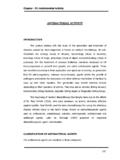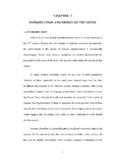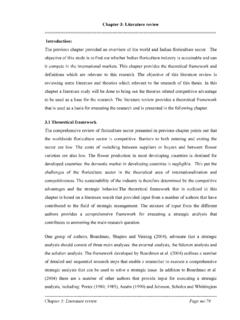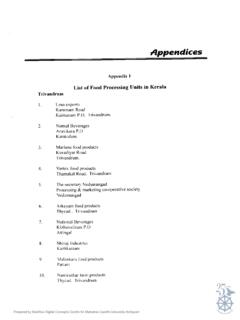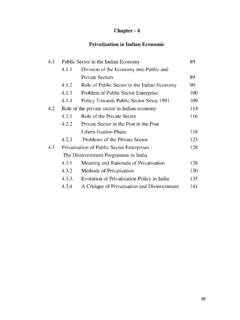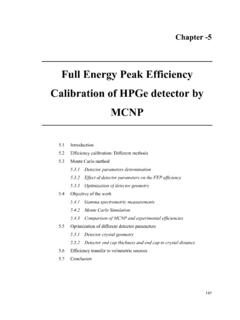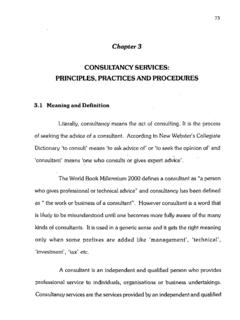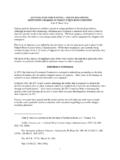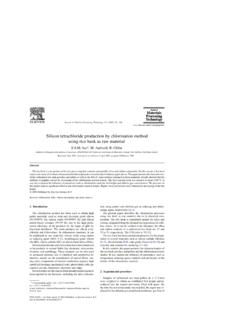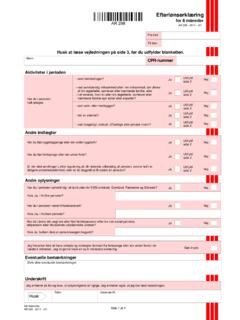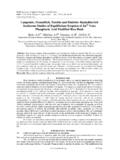Transcription of CHAPTER 2 RICE HUSK A REVIEW 2.1 …
1 CHAPTER 2 RICE husk A REVIEW INTRODUCTION In this CHAPTER , basic properties and structure of rice husk ; uses and application of rice husk ash in various industries have been discussed. RICE PRODUCTION Paddy rice (Oryza sativa) is grown on every continent except Antarctica and the extent of paddy cultivation covers about 1 percent of the earth s surface. More than half of the world s population depends on rice as a staple food and it ranks second to wheat in terms of cultivation area and production. The quantum of global production of paddy is close to 650 million tons per annum [ of ]. Production of rice is dominated by Asia, where rice is the only food crop that can be grown during the rainy season in the waterlogged tropical areas.
2 Asia generates over 90 percent of world rice production (Table ). Together, China and India accounted for over half of the world s rice supply [ of ]. In India, Tamil Nadu is the third ranking state in the production of paddy after Andhra Pradesh and West Bengal. Paddy production is nearly 7 million tonnes in Tamil Nadu [ of ]. Paddy, on an average, consists of about 72 percent of rice, 5-8 percent of bran, and 20-22 percent of husk [Prasad et al., 2000]. Of all the plant residues, the ash of rice husk contains the highest proportion of silica. It is estimated that every tonne of paddy produces about tonnes of husk and every tonne of husk produces about to tonnes of ash, depending on the variety, climatic conditions and geographical location [Prasad et al.]
3 , 2000 and Bouzoubaa and Fournier, 2001]. The total global ash production could be as high as about 23 million tonnes per year (Table ). 6 PROPERTIES OF RICE husk Rice husk is a potential material, which is amenable for value addition. The usage of rice husk either in its raw form or in ash form is many. Most of the husk from the milling is either burnt or dumped as waste in open fields and a small amount is used as fuel for boilers, electricity generation, bulking agents for composting of animal manure, etc [Bronzeoak, 2003; Asavapisit and Ruengrit, 2005]. The exterior of rice husk are composed of dentate rectangular elements, which themselves are composed mostly of silica coated with a thick cuticle and surface hairs.
4 The mid region and inner epidermis contain little silica [Bronzeoak, 2003]. Jauberthie et al., (2000) confirmed that the presence of amorphous silica is concentrated at the surfaces of the rice husk and not within the husk itself. The chemical composition of rice husk is similar to that of many common organic fibers and it contains of cellulose 40-50 percent, lignin 25-30 percent, ash 15-20 percent and moisture 8- 15 percent [Hwang and Chandra, 1997]. After burning, most evaporable components are slowly lost and the silicates are left. The typical properties of rice husk are indicated in Table No other plant except paddy husk is able to retain such a huge proportion of silica in it.
5 Plants absorb various minerals and silicates from earth into their body. Inorganic materials, especially silicates are found in higher proportions in annually grown plants, such as rice, wheat, sunflower, etc, than in long-lived trees. Inorganic materials are found in the form of free salts and particles of cationic groups combined with the anionic groups of fibres into the plants [Basha et al., 2005]. A combined study using back scattered electron and X-ray images of the husk (Fig. ) showed that the silica is distributed mostly under the husk s outer surface [Stroeven et al., 1999]. This 7 confirms the general concept of a soluble form of silica transported through the plant, and concentrated at the outer surface of straw and husk through evaporation, whereupon it polymerizes into an opaline cellulose-silica.
6 THERMAL DECOMPOSITION OF RICE husk There are two distinct stages in the decomposition of rice husk - carbonization and decarbonation. Carbonization is the decomposition of volatile matter in rice husk at temperature greater than 300 C and releases combustible gas and tar. Decarbonation is the combustion of fixed carbon in the rice husk char at higher temperature in the presence of oxygen (Fig. ) [Maeda et al., 2001]. The melting temperature of RHA is estimated as 1440 C, that is, the temperature at which silica melts [Bronzeoak, 2003]. FORMS OF SILICA IN RHA Rice husk ash contains 87-97 percent of silica with small amount of alkalis and other trace elements.
7 Based on temperature range and duration of burning of the husk , crystalline and amorphous forms of silica are obtained [Stroeven et al., 1999; Hwang and Chandra, 1997; Asavapisit and Ruengrit, 2005 and Basha et al., 2005]. The crystalline and amorphous forms of silica have different properties and it is important to produce ash with correct specifications for specific end use. Generally, the amorphous forms of silica are composed of silica tetrahedral arranged in a random three-dimensional network without regular lattice structures (Fig. ). Due to disordered arrangement, the structure is open with holes in the network where electrical neutrality is not satisfied and the specific surface area is also large.
8 This helps to increase the reactivity, since large area is available for reaction to take place [Shomglin et al., 2001]. 8 The structure of crystalline silica is built by repetition of a basic unit the silicon tetrahedron in an oriented three-dimensional framework. In framework type structure ( quartz), the silicon tetrahedrons are joined through the vertices by oxygen, each of which is linked to two silicon atoms (Fig. ). The oxygen to silicon ratio equals to 2:1, thus electrical neutrality is attained [Shomglin et al., 2001]. The silica occurs in several forms within the rice husks are at the molecular level and it is associated with water.
9 In nature, the polymorphs of silica are quartz, cristobalite, tridymite, coestite, stishovite, lechatelerite and silica gel [Bronzeoak, 2003]. It is this silica concentrated in husk by burning which makes the ash so valuable. APPLICATIONS OF RICE husk ASH RHA has got numerous applications in silicon based industries. Substantial research has been carried out on the use of RHA as a mineral admixture in the manufacture of concrete. RHA in amorphous form can be used as a partial substitute for Portland cement and as an admixture in high strength and high performance concretes. A REVIEW on the use of RHA by the construction industry, in particular on concrete production has been separately dealt in CHAPTER -5.
10 Apart from this specific use, it has many other usages as given below: Due to its refractory properties, crystalline RHA is the most wanted material for steel industries, ceramic industry and for the manufacture of refractory bricks [Prasad et al., 2000 and Bronzeoak, 2003]. Basha et al., (2005) examined the possibilities of improving residual soil properties by mixing RHA and cement in suitable proportions as stabilizing agent. 9 Indian Space Research Organization has successfully developed a technology for producing high purity silica from RHA that can be used in silicon chip manufacture [Bronzeoak, 2003]. Naito (1999) introduced a low cost technology for controlling insect pests in Soya beans by using RHA.
